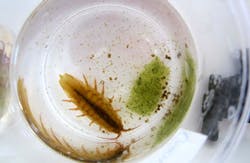Not all marine creatures harmed by microplastics, study finds
Recent studies have highlighted just how much plastic litters the oceans — billions of pieces can be found from the surface to the deepest seas in every corner of the world.
But not all creatures are harmed by microplastics in the water, new research suggests.
Biologists at the North Sea Office of the Alfred Wegener Institute, Helmholtz Centre for Polar and Marine Research (AWI), found that ingestion of microplastic particles does not mechanically affect marine isopods.
Lars Gutow and colleagues conducted feeding experiments with the isopod Idotea emarginata, offering the creatures artificial algal food supplemented with plastic particles in varying concentrations. Over six to seven weeks, three different kinds of microplastics were added to the food: industrially produced polystyrene particles with a diameter of 10 micrometers as well as self-made fragments and fibres made of polyethylene and polyacryl.
Results showed that the concentration of microplastics in the fecal material of the isopods was as high as in the food. Small amounts of microplastics were found both in the stomach and in the gut of the creatures, but no microparticles were detected in the digestive glands.
"The isopods ingested and excreted the artificial food with the microplastic particles without absorbing or accumulating the particles," Gutow said.
The scientists concluded that plastic particles in the size range studied do not represent a direct mechanical risk for isopods and the same is probably true for other crustaceans.
But it's clear that different species react differently. In an earlier study, AWI biologist Prof. Dr. Angela Kˆhler demonstrated that mussels show inflammatory reactions if they take up and absorb high concentrations of microplastic.
Research will continue. The scientists plan to examine possible chemical (toxic) and biochemical effects in addition to physical effects. Ultimately, they want to form a risk matrix on the sensitivity of different marine species to microplastic pollution.
The findings of the latest study have been published in the journal Environmental Science and Technology.
